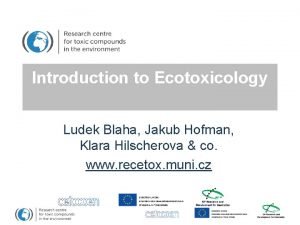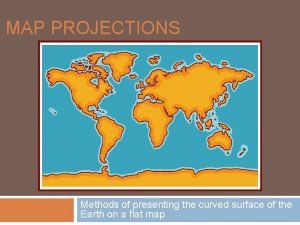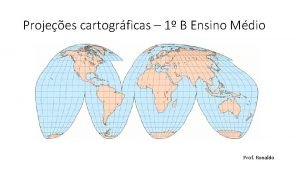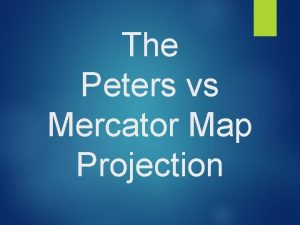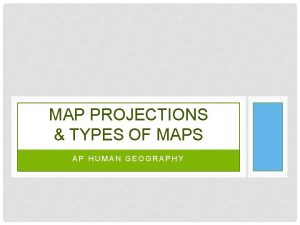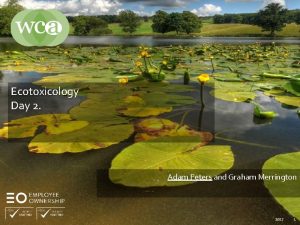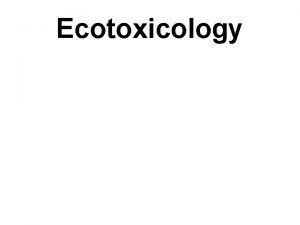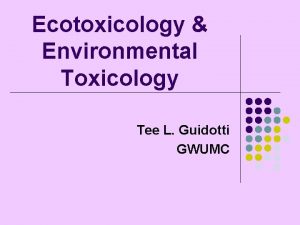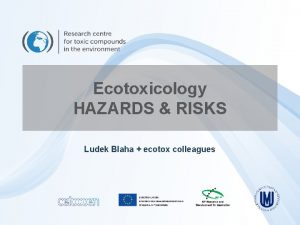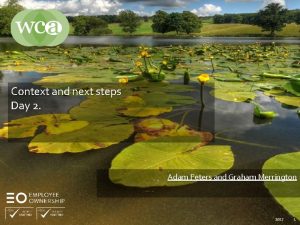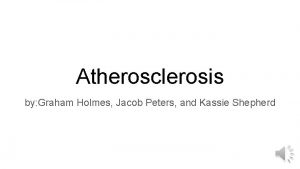Ecotoxicology Day 2 Adam Peters and Graham Merrington















- Slides: 15

Ecotoxicology Day 2. Adam Peters and Graham Merrington 2017 1

§ § § What is a ecotoxicology? Endpoints Test principles and interpretation Hypothesis testing Regression modelling/curve fitting Reliability and relevance 2017 2

What is a ecotoxicology? (ECHA 2011, R 7 b) again § Typically standardised tests aimed at comparing different chemicals § Simple tests on organisms which are readily cultured in the lab § Standardised test procedures § Performance of control animals critical for a valid test § Tests usually performed under optimum conditions for the test species 2017 3

Endpoints? § What counts as an effect? § Acute – Mortality § Chronic – endpoints relating to development, growth, or reproduction § What kinds of plants and animals get tested? § Unicellular green algae § Water fleas (Daphnia) § Fish 2017 4

Testing? (OECD 201, 202, 203, etc. ) § § § Acute Daphnia test 10 water fleas in plastic cups Are they alive or not? Prod with a pencil, does it move? If it doesn’t move it’s immobilised » (presumed dead) § Endpoint is immobilisation » Assumed equivalent to mortality 2017 5

Results? § 10 Water fleas (Daphnia) § All alive – no effects § All dead – 100% effects » Lethal Concentration LC 100, Effective Concentration EC 100 § 5 dead, 5 alive – 50% effects » LC 50 or EC 50 2017 6

Statistical Analysis § ANOVA – Analysis of variance § Requires replication at each test concentration level § Identifies a difference from the control § Used to identify the highest test concertation with no effects » No Observed Effects Concentration (NOEC) § Lowest test concentration at which a significant effect was observed » Lowest Observed Effect Concentration (LOEC) 2016 7

Alternative Approach § Curve fitting § Uses data from the entire experiment § Allows more test concentrations with fewer replicates for each one » Same total number of replicates § Allows calculation of any effect level » EC 10, EC 25, EC 50, EC 90 § EC 10 usually treated as equivalent to a NOEC for PNEC and EQS derivation in Europe 2016 8

Test Quality and Standardisation § Most tests conducted to OECD standard guidelines § Many also conducted to GLP § Reliability criteria specific to each test » Information in test guidelines § Control performance? » Minimum performance required for a valid test » Usually based on endpoint used § Standardised water chemistry common » Different for different test species 2016 9

Chronic tests § Usually same test species § For deriving longer term thresholds more reliably § Relevant endpoints growth or reproduction » » » » Algae Daphnia Fish Rotifer Plant Molluscs Insect population growth reproduction (# of offspring) growth (biomass, length) or development population growth root growth (biomass, shell length) growth (biomass, length) 2016 10

Data Sources § § Study summaries e. g. IUCLID/ECHA Study reports – if available Open literature Other reviews – OECD, ICCA, ESR, NICNAS, ECETOC » Thresholds may not be directly usable, but data should have been reviewed and summarised » Different interpretation of the same data may be required » NOEC vs EC 10 vs EC 25, SSD vs deterministic, AF? 2017 11

What Data Counts § Test data for a species which is not locally or regionally relevant is taken as being representative of other untested locally and regionally relevant species § Include all reliable and relevant data § Relevant endpoints should have a direct link to population viability » Many behavioural endpoints are not relevant! 2017 12

Non standard tests § Usually from research laboratories § Different species and taxonomic groups which might be required to represent an ecosystem § Insects, molluscs, plants, worms, etc. § Can be difficult to assess adequacy of control performance without guidance » Difficulties in drawing conclusions about the test § Could also be standard species under non-standard test conditions, or in natural waters 2017 13

Summary § § Standardised species Standardised tests Standardised endpoints Existing regulatory summaries 2017 14

2016 15
 Ecotoxicology
Ecotoxicology Day 1 day 2 day 3 day 4
Day 1 day 2 day 3 day 4 What does jennifer peters do on a typical day
What does jennifer peters do on a typical day Every week his mother goes to university
Every week his mother goes to university Day 1 day 2 day 817
Day 1 day 2 day 817 Adam white speaks
Adam white speaks Business plan chapter 7
Business plan chapter 7 Gall-peters projection pros and cons
Gall-peters projection pros and cons Projeção de buckminster fuller
Projeção de buckminster fuller Anamorfose
Anamorfose John wright character analysis
John wright character analysis Diferença da projeção de mercator e peters
Diferença da projeção de mercator e peters Reimagine tom peters
Reimagine tom peters Mercator vs peters
Mercator vs peters Mercator projection ap human geography
Mercator projection ap human geography Simon peters death
Simon peters death
